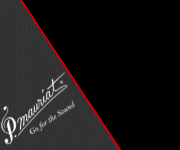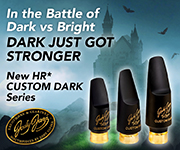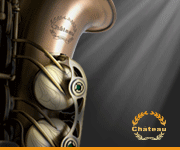-
-

by birdlover
(43 posts)
11 years ago
Re: Identifying a Conn Tenor
Regarding intonation, I’ve also seen a fight between a Selmer Mark Six owner and a Selmer Balanced Action fan over intonation. Mr. Mark Six said the BA had intonation problems, Mr. BA said the Mark Six had intonation problems, and it almost came to a fist fight. LOL.
I have several Conns from various years, both altos and tenors and never really had any issues with intonation on any of them, I also own a couple Yanis, and they have good intonation as well. It seems to me that good intonation comes from listening more than anything else. However I do think that the old Conns have more flexibility than the modern horns do as far as bending notes but that could be my imagination. Leaks cause intonation problems, but I have read that saxophones built prior to 1918 had poor intonation. I also have a King Super 20 tenor made around 1948 or 49, it has no problems with intonation either, so I have all these old horns and a few modern horns and the intonation seems to be about the same on all of them. But, who knows, I’m not an expert, I just love old technology, and I admire the technology on newer horns, so I have fun with all of ‘em. Play and be happy.
Reply To Post
-

by GFC
(842 posts)
11 years ago
Re: Identifying a Conn Tenor
They were protecting their investments!
Reply To Post
-

by birdlover
(43 posts)
11 years ago
Re: Identifying a Conn Tenor
Indeed they were, but I kept my distance.
Reply To Post
-

by Saxquest
(420 posts)
11 years ago
Re: Identifying a Conn Tenor
1920 vintage Conn New Wonder tenor saxophone. This could be a great saxophone if restored properly. The L is for "low pitch" and the patd number and date reffer to Conn's patent for drawing or extruding tone holes from the body tube of the saxophone. This is of the first year that Conn rolled tone holes. Your horn is on the cusp. If it has rolled tone holes, it has decent collectability. If not, then not so much.
Check out the museum section of this web site for more information about the early New Wonder model from C.G. Conn.
These tenors have a big sound with a very spread core. Intonation is usually a bit suspect, but varies from horn to horn. The key work is definitely entiquated, but livable. These are fun horns to play and worth restoring. Best of Luck!!
Cheers,
Mark Overton
www.saxquest.com
Reply To Post
-

by stanmiro
(1 post)
10 years ago
Re: Identifying a Conn Tenor
HI
I have similar horn what it seem to be "New Wonder II" Tenor , SN M236332
I been having intonation problem when playing in higher stack, tried different mouthpieces and from ones I have try the Link (note Edge *6) seem to be best, but still when it gets to higher range intonation is a problem..
Wonder if it is proper mouthpiece that I need to continue to look for or something else that needs to be done, check with the horn to eliminate/minimize this intonation isssue.
Also, found that keywork is really high, and was advised that they can be lowered.. Is it something that can be done normally withought impacting sound/intonation of the horn?
Your advise/opinion would be greatly appreciated.
Miro
Reply To Post
-

by GFC
(842 posts)
10 years ago
Re: Identifying a Conn Tenor
How did the chamber sizes on the other mouthpieces compare with that of the Tone edge? Conns get along best with large chamber pieces.
The New Wonder has very flexible intonation, so it puts more on the player to achieve good intonation than a horn with more slotted intonation would. For some players that's a deal breaker, but if you want that deep, dark, rich New Wonder goodness it's just something you've got to deal with. My first question would be whether you're taking in enough of the mouthpiece and using good airstream control. The mouthpiece should be inserted past the break of the facing. Tongue position should be similar to that for saying "eeee." Before I learned to do those things, I was wrestling intonation with my lips - not good.
Optimal key heights are exactly at the point certain critical keys can be lowered to without making the note stuffy or flat. They vary from horn to horn.
Reply To Post
-

by dicklourie
(3 posts)
11 years ago
Re: Identifying a Conn Tenor
Thanks very much! I’m very appreciative, and will let my friend know that this is definitely worth restoring. One more (very odd, I think) question: Someone has suggested that the “60010” serial number is actually the zip code for Barrington, Illinois. This would signify that the instrument was manufactured there—But was Conn ever in that Illinois town? And even if so, why would the zip code be found there instead of a serial #. Seems to me like a bizarre coincidence. Any enlightenment would be appreciated.
Reply To Post
-

by GFC
(842 posts)
11 years ago
Re: Identifying a Conn Tenor
It is definitely not a zip code. Zip codes came into being in the 1960s.
There are a couple of things to consider before jumping into a restoration. One is that you haven't answered whether it has rolled tone holes or not. If not, it's probably not worth much and recovering the cost of a restoration would be difficult. The other is that an early 1920s "New Wonder I" is not nearly as valuable as a late 1920s "New Wonder II" because the keywork was not as well made, which presents problems for repair techs and players. If the horn needs more than about $1000 in restoration work that could exceed the value of the horn. Have it looked at by a repair tech who really knows old Conn saxophones to get an estimate of the cost of a restoration and whether or not it would be worthwhile. That is not a job for a local music store school band instrument tech. If the horn turns out to be a carcass, contact Matt Stohrer at stohrermusic.com. He is interested in acquiring New Wonder Is for keywork conversion projects and might be interested in a deal. He is also very knowledgable about old Conns and could give a good estimate oof what it would take to restore it.
Reply To Post
-

by dicklourie
(3 posts)
11 years ago
Re: Identifying a Conn Tenor
Again, many thanks. I will pass all this on to my friends who have seen the horn (I’m going by their description). Whatever is done to it, I will hope to see in a few months.
I’m really grateful for the expert peer communication being shared in this forum.
Dick Lourie
Reply To Post
-

by GFC
(842 posts)
11 years ago
Re: Identifying a Conn Tenor
Conn New Wonder tenor from 1920, low pitch. As a low pitch horn it is playable with modern instruments. Good sounding horns.
Reply To Post
-

by turtlejimmy
(14 posts)
11 years ago
Re: Identifying a Conn Tenor
I have one of these (1924) that was fully restored by experts .... My sax teacher who has been a pro for 35 years called it the best tenor he ever played. DEFINITELY worth restoring.
Sazquest describes it perfectly, right down to the very spread core .... Stick and Otto Link on it and you've got a very similar setup to Dexter Gordon. It certainly isn't the easiest horn to play but the keywork, after some time, becomes comfortable and it's very fast. A very open playing horn, flexible and with a huge sound. I think they are large bore horns.
It's not easy to find a modern case that will fit these split bell keys .... But a Protec Propac works well.
Turtle
Reply To Post
-

by turtlejimmy
(14 posts)
11 years ago
Re: Identifying a Conn Tenor
BTW, mine has great intonation ..... could have been the restoration that helped or it's just one of the lucky ones.
Turtle
Reply To Post
-

by turtlejimmy
(14 posts)
11 years ago
Re: Identifying a Conn Tenor
Also, after re-reading the posts, GFC has good advice, I think. The restoration of my Conn cost quite a lot, according to the previous owner .... who didn't know where the work was done. But, he heard from the wife of the former owner that it was extensive, and expensive.. The end result is impressive, but I don't know if I would have paid for that. An expert opinion, like he suggested, would be invaluable. Good luck with it!
Turtle
Reply To Post
|
 Forgot Username? Forgot Password?
Forgot Username? Forgot Password?





